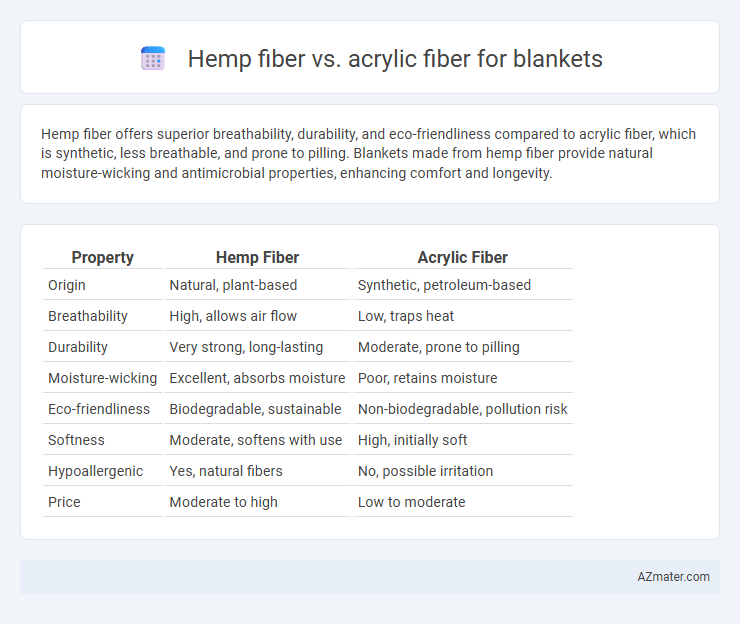Hemp fiber offers superior breathability, durability, and eco-friendliness compared to acrylic fiber, which is synthetic, less breathable, and prone to pilling. Blankets made from hemp fiber provide natural moisture-wicking and antimicrobial properties, enhancing comfort and longevity.
Table of Comparison
| Property | Hemp Fiber | Acrylic Fiber |
|---|---|---|
| Origin | Natural, plant-based | Synthetic, petroleum-based |
| Breathability | High, allows air flow | Low, traps heat |
| Durability | Very strong, long-lasting | Moderate, prone to pilling |
| Moisture-wicking | Excellent, absorbs moisture | Poor, retains moisture |
| Eco-friendliness | Biodegradable, sustainable | Non-biodegradable, pollution risk |
| Softness | Moderate, softens with use | High, initially soft |
| Hypoallergenic | Yes, natural fibers | No, possible irritation |
| Price | Moderate to high | Low to moderate |
Introduction to Hemp and Acrylic Fibers
Hemp fiber, derived from the stalks of the Cannabis sativa plant, is valued for its natural strength, breathability, and eco-friendly properties, making it an ideal choice for sustainable blankets. Acrylic fiber, a synthetic material made from polymer compounds, offers lightweight durability, softness, and resistance to moisture, commonly used in affordable and easy-care blankets. Both fibers provide distinct advantages, with hemp emphasizing environmental benefits and durability, while acrylic highlights versatility and ease of maintenance.
Sustainability and Environmental Impact
Hemp fiber stands out for its sustainability due to its rapid growth, minimal water requirements, and biodegradability, making it an eco-friendly choice for blankets. In contrast, acrylic fiber, derived from petrochemicals, contributes to pollution through its production process and is non-biodegradable, leading to long-term environmental waste. Choosing hemp fiber blankets significantly reduces carbon footprint and supports soil health compared to the synthetic and resource-intensive nature of acrylic fibers.
Softness and Comfort Comparison
Hemp fiber offers natural breathability and softness that improves with use, providing a comfortable, hypoallergenic experience ideal for sensitive skin in blankets. Acrylic fiber, while initially soft and lightweight, may trap heat and cause static, reducing overall comfort during extended use. Hemp's moisture-wicking properties and durability make it a superior choice for blankets focused on long-term softness and comfort.
Durability and Longevity
Hemp fiber exhibits superior durability and longevity compared to acrylic fiber due to its natural strength and resistance to wear, making it ideal for blankets that require long-term use. Hemp fibers are highly resilient, maintaining their integrity and softness after multiple washes without pilling or weakening. Acrylic fiber, while lightweight and affordable, tends to degrade faster with repeated laundering, leading to reduced durability and a shorter lifespan in blanket applications.
Warmth and Insulation Properties
Hemp fiber offers superior breathability and natural thermal regulation, making it an excellent choice for blankets that provide warmth without overheating. Acrylic fiber excels in insulation by trapping heat efficiently but may lack moisture-wicking capabilities, leading to less comfort in varied temperatures. For blankets prioritizing warmth and insulation, hemp fiber ensures consistent warmth with added durability and eco-friendliness compared to synthetic acrylic alternatives.
Moisture Absorption and Breathability
Hemp fiber outperforms acrylic fiber in moisture absorption, with the ability to absorb up to 20% of its weight in water, making it highly effective at managing sweat and humidity. Its natural breathability allows for superior air circulation, keeping blankets cool and comfortable in warm conditions. Acrylic fiber, being synthetic, has lower moisture-wicking properties and limited breathability, which can result in less comfort and increased heat retention during use.
Care and Maintenance Requirements
Hemp fiber blankets require minimal care, featuring natural resistance to mold, mildew, and UV light, making them durable and eco-friendly with easy machine washing in cold water and air drying recommended to preserve fiber integrity. Acrylic fiber blankets demand careful maintenance to avoid pilling and maintain softness, typically requiring gentle machine wash cycles with mild detergents and low heat drying to prevent excessive static buildup and fiber damage. Both fibers benefit from avoiding bleach and fabric softeners, but hemp's natural robustness offers a lower-maintenance option for long-lasting blanket care.
Allergenicity and Skin Sensitivity
Hemp fiber exhibits low allergenicity and is naturally hypoallergenic, making it ideal for individuals with sensitive skin or allergies. In contrast, acrylic fiber often contains synthetic chemicals that can trigger skin irritation or allergic reactions, especially in people prone to sensitivities. Choosing hemp fiber blankets reduces the risk of contact dermatitis and ensures breathable, moisture-wicking comfort for sensitive skin types.
Cost and Market Availability
Hemp fiber blankets typically cost more due to the sustainable cultivation process and lower production scale compared to acrylic fiber, which is mass-produced and widely available at a lower price point. Acrylic fiber dominates the blanket market with extensive availability in various styles and price ranges, making it a common choice for budget-conscious consumers. Hemp fiber blankets appeal to niche markets focused on eco-friendly and durable textiles, but their higher cost and limited market presence restrict widespread adoption.
Conclusion: Choosing the Best Fiber for Blankets
Hemp fiber offers exceptional durability, breathability, and natural antimicrobial properties, making it ideal for eco-friendly and long-lasting blankets. Acrylic fiber provides softness, vibrant color retention, and affordability but may lack the sustainability and breathability of hemp. Choosing the best fiber depends on prioritizing either natural, durable performance with hemp or cost-effective, soft texture with acrylic for blanket construction.

Infographic: Hemp fiber vs Acrylic fiber for Blanket
 azmater.com
azmater.com